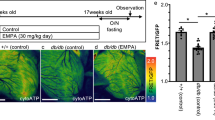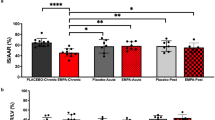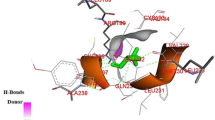Abstract
Purpose
Cardiotoxicity is a well-known side effect of chloroquine. Several studies have proposed chloroquine as a potential anti-diabetic treatment but do not address this problem. The current study investigated the effect of ex vivo chloroquine treatment on (1) heart function and glucose uptake, (2) mitochondrial function and (3) in vivo treatment on heart function.
Methods
Control or obese male Wistar rats were used throughout. Dose responses of increasing chloroquine concentrations versus vehicle on cardiac function were measured using isolated, Langendorff-perfused hearts whilst glucose uptake and cell viability were determined in ventricular cardiomyocytes. Mitochondrial function was assessed with a Clark-type oxygraph (Hansatech) after ex vivo perfusion with 30 μM chloroquine versus vehicle. Animals were treated orally with 5 mg/kg/day chloroquine for 6 weeks.
Results
Acute chloroquine treatment of 10 μM was sufficient to significantly decrease heart function (p < 0.05) whilst 30 μM significantly reduced heart rate (p < 0.05). Chloroquine became toxic to isolated cardiomyocytes at high concentrations (100 μM), and had no effect on cardiomyocyte glucose uptake. Ex vivo treatment did not affect mitochondrial function, but chronic low-dose in vivo chloroquine treatment significantly decreased aortic output and total work in hearts (p < 0.005).
Conclusion
Low and intermediate chloroquine doses administered either chronically or acutely are sufficient to result in myocardial dysfunction.





Similar content being viewed by others
References
Hage MP, Badri MR, Azar ST. A favorable effect of hydroxychloroquine on glucose and lipid metabolism beyond its anti-inflammatory role. Ther Adv Endocrinol Metab. 2014;5:77–85.
Smith GD, Amos TA, Mahler R, Peters TJ. Effect of chloroquine on insulin and glucose homoeostasis in normal subjects and patients with non-insulin-dependent diabetes mellitus. Br. Med. J. (Clin. Res. Ed). 1987;294:465–7.
Wasko MCM, McClure CK, Kelsey SF, Huber K, Orchard T, Toledo FGS. Antidiabetogenic effects of hydroxychloroquine on insulin sensitivity and beta cell function: a randomised trial. Diabetologia. 2015;58:2336–43.
Chen Y-M, Lin C-H, Lan T-H, Chen H-H, Chang S-N, Chen Y-H, et al. Hydroxychloroquine reduces risk of incident diabetes mellitus in lupus patients in a dose-dependent manner: a population-based cohort study. Rheumatology. 2015;54:1244–9.
Asamoah KA, Robb DA, Furman BL. Chronic chloroquine treatment enhances insulin release in rats. Diabetes Res Clin Pract. 1990;9:273–8.
Powrie JK, Shojaee-Moradie F, Watts GF, Smith GD, Sönksen PH, Jones RH. Effects of chloroquine on the dyslipidemia of non-insulin-dependent diabetes mellitus. Metabolism. 1993;42:415–9.
Powrie JK, Smith GD, Shojaee-Moradie F, Sonksen PH, Jones RH. Mode of action of chloroquine in patients with non-insulin-dependent diabetes mellitus. Am J Physiol Metab Am Physiol Soc. 1991;260:E897–904.
Shintani T, Klionsky DJ. Autophagy in health and disease: a double-edged sword. Science (80-. ). 2004;306:990–5.
Bevan AP, Krook A, Tikerpae J, Seabright PJ, Siddle K, Smith GD. Chloroquine extends the lifetime of the activated insulin receptor complex in endosomes. J Biol Chem. 1997;272:26833–40.
Zhou Q, Yang X, Xiong M, Xu X, Zhen L, Chen W, et al. Chloroquine increases glucose uptake via enhancing GLUT4 translocation and fusion with the plasma membrane in L6 cells. Cell Physiol Biochem. 2016;38:2030–40.
Halaby M-J, Kastein BK, Yang D-Q. Chloroquine stimulates glucose uptake and glycogen synthase in muscle cells through activation of Akt. Biochem. Biophys. Res. Commun. Elsevier Inc. 2013;435:708–13.
Ben-Zvi I, Kivity S, Langevitz P, Shoenfeld Y. Hydroxychloroquine: from malaria to autoimmunity. Clin Rev Allergy Immunol. 2012;42:145–53.
Cansu DÜ, Korkmaz C. Hypoglycaemia induced by hydroxychloroquine in a non-diabetic patient treated for RA. Rheumatology. 2008;47:378–9.
Schneider JG, Finck BN, Ren J, Standley KN, Takagi M, Maclean KH, et al. ATM-dependent suppression of stress signaling reduces vascular disease in metabolic syndrome. Cell Metab. 2006;4:377–89.
Kanamori H, Takemura G, Goto K, Tsujimoto A, Mikami A, Ogino A, et al. Autophagic adaptations in diabetic cardiomyopathy differ between type 1 and type 2 diabetes. Autophagy. 2015;11:1146–60.
Poulsen MK, Henriksen JE, Dahl J, Johansen A, Gerke O, Vach W. Left ventricular diastolic function in type 2 diabetes mellitus prevalence and association with myocardial and vascular disease. Circ Cardiovasc Imaging. 2010;3:24–31.
Riehle C, Abel ED. Insulin regulation of myocardial autophagy. Circ J. 2014;78:2569–76.
Chaanine AH, Gordon RE, Nonnenmacher M, Kohlbrenner E, Benard L, Hajjar RJ. High-dose chloroquine is metabolically cardiotoxic by inducing lysosomes and mitochondria dysfunction in a rat model of pressure overload hypertrophy. Physiol Rep. 2015;3:1–18.
Page RL II, O’Bryant CL, Cheng D, Dow TJ, Ky B, Stein CM, et al. Drugs that may cause or exacerbate heart failure. Circulation. 2016;134:e32–e69
Redmann M, Benavides GA, Berryhill TF, Wani WY, Ouyang X, Johnson MS, et al. Inhibition of autophagy with bafilomycin and chloroquine decreases mitochondrial quality and bioenergetic function in primary neurons. Redox Biol Elsevier B.V. 2017;11:73–81.
Reagan-Shaw S, Nihal M, Ahmad N. Dose translation from animal to human studies revisited. FASEB J. 2007;22:659–61.
Marmor MF, Kellner U, Lai TYY, Melles RB, Mieler WF, Lum F. Recommendations on screening for chloroquine and hydroxychloroquine retinopathy (2016 revision). Ophthalmology Elsevier. 2016;123:1386–94.
Costedoat-Chalumeau N, Hulot J-S, Amoura Z, Delcourt A, Maisonobe T, Dorent R, et al. Cardiomyopathy related to antimalarial therapy with illustrative case report. Cardiology. 2007;107:73–80.
Tönnesmann E, Stroehmann I, Kandolf R, Strach K, Musshoff F, Tiemann K, et al. Cardiomyopathy caused by longterm treatment with chloroquine: a rare disease , or a rare diagnosis? J Rheumatol. 2012;39:1099–103.
Cervera A, Espinosa G, Cervera R, Font J, Ingelmo M. Cardiac toxicity secondary to long term treatment with chloroquine. Ann Rheum Dis. 2001;60:301–4.
Yogasundaram H, Putko BN, Tien J, Paterson DI, Cujec B, Ringrose J, et al. Hydroxychloroquine-induced cardiomyopathy: case report, pathophysiology, diagnosis, and treatment. Can J Cardiol Can Cardiovasc Soc. 2014;30:1706–15.
Yogasundaram H, Hung W, Paterson ID, Sergi C, Oudit GY. Chloroquine-induced cardiomyopathy: a reversible cause of heart failure. ESC Hear Fail. 2018;5:372–5.
Razani B, Feng C, Semenkovich CF. P53 is required for chloroquine-induced atheroprotection but not insulin sensitization. J Lipid Res. 2010;51:1738–46.
Fischer Y, Rose H, Kammermeier H. Highly insulin-responsive isolated rat heart muscle cells yielded by a modified isolation method. Life Sci. 1991;49:1679–88.
Lowry OH, Rosebrough NJ, Farr AL, Randall RJ. Protein measurement with the Folin henol reagent. J Biol Chem. 1951;193:265–75.
Maarman G, Marais E, Lochner A, Toit EF. Effect of chronic CPT-1 inhibition on myocardial ischemia- reperfusion injury ( I / R ) in a model of diet-induced obesity. Cardiovasc Drugs Ther. 2012;26:205–16.
Kannengiesser GJ, Lubbe WF, Opie LH. Experimental myocardial infarction with left ventricular failure in the isolated perfused rat heart. Effects of isoproterenol and pacing. J Mol Cell Cardiol Elsevier. 1975;7:135–51.
Gerstein HC, Thorpe KE, Taylor DW, Haynes RB. The effectiveness of hydroxychloroquine in patients with type 2 diabetes mellitus who are refractory to sulfonylureas - a randomized trial. Diabetes Res Clin Pract. 2002;55:209–19.
White NJ. Cardiotoxicity of antimalarial drugs. Lancet Infect Dis. 2007;7:549–58.
Huisamen B, Dietrich D, Bezuidenhout N, Lopes J, Flepisi B, Blackhurst D, et al. Early cardiovascular changes occurring in diet-induced, obese insulin-resistant rats. Mol Cell Biochem. 2012;368:37–45.
Burchfield JG, Kebede MA, Meoli CC, Stöckli J, Whitworth PT, Wright AL, et al. High dietary fat and sucrose result in an extensive and time-dependent deterioration in health of multiple physiological systems in mice J Biol Chem. 2018;293:5731–5745.
Sumiyoshi M, Sakanaka M, Kimura Y. Nutrient physiology, metabolism, and nutrient-nutrient interactions chronic intake of high-fat and high-sucrose diets differentially affects glucose intolerance in mice. J Nutr. 2006;136:582–7.
Spears LD, Tran A V, Qin CY, Hobbs SB. Chloroquine increases phosphorylation of AMPK and Akt in myotubes. Heliyon. 2016 Mar;2(3):e00083.
Wagner M, Riepe KG, Eberhardt E, Volk T. Open channel block of the fast transient outward K+current by primaquine and chloroquine in rat left ventricular cardiomyocytes. Eur J Pharmacol Elsevier B.V. 2010;647:13–20.
Grover GJ, Garlid KD. ATP-sensitive potassium channels: a review of their cardioprotective pharmacology. J Mol Cell Cardiol. 2000;32:677–95.
Sánchez-Chapula JA, Salinas-Stefanon E, Torres-Jácome J, Benavides-Haro DE, Navarro-Polanco RA. Blockade of currents by the antimalarial drug chloroquine in feline ventricular myocytes. J Pharmacol Exp Ther. 2001;297:437–45.
Funding
We acknowledge funding from the South African National Research Foundation.
Author information
Authors and Affiliations
Corresponding author
Ethics declarations
All applicable international, national, and institutional guidelines for the care and use of animals were followed. All procedures performed in studies involving animals were in accordance with the ethical standards of the institution at which the studies were conducted. This study was approved by the Stellenbosch University Research Ethics Committee: Animal Care and Use (Protocol number SU-ACUM12-00040; SU-ACUD16-0079) and complied with the accepted national and international standards for the use of animals in research as stipulated in the South African National Standards 10386: 2008. This article does not contain any studies with human participants performed by any of the authors.
Conflict of Interest
The authors declare that they have no conflict of interest.
Additional information
Publisher’s Note
Springer Nature remains neutral with regard to jurisdictional claims in published maps and institutional affiliations.
Rights and permissions
About this article
Cite this article
Blignaut, M., Espach, Y., van Vuuren, M. et al. Revisiting the Cardiotoxic Effect of Chloroquine. Cardiovasc Drugs Ther 33, 1–11 (2019). https://doi.org/10.1007/s10557-018-06847-9
Published:
Issue Date:
DOI: https://doi.org/10.1007/s10557-018-06847-9




